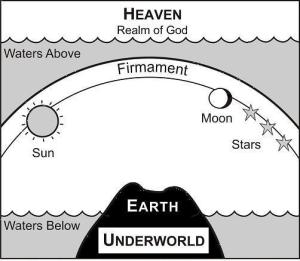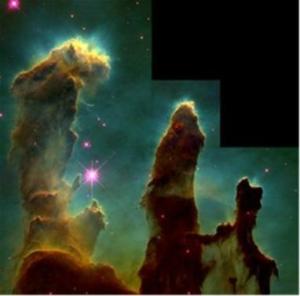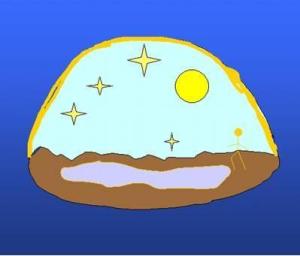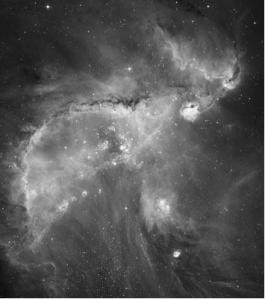I’ve been promising to respond with my own answer to Einstein’s question: Is the universe friendly? Needless to say, it’s one thing to pose the question rhetorically and quite another to be expected to answer it oneself, which helps account for the time it has taken to get here.
My answer is tied up in two cosmologies. First, there is the cosmology that has marked the thinking of Western civilization for some four thousand years. The second is the cosmology of today, the Hubble version. First, the ancient Near Eastern view; we still tend to think this way, especially those who are linked to Western religious literature.
I think of this cosmos as a snow globe. It sits at the very center of a large crystal globe, the latter marking the extent of the universe (beyond the border of the square picture here). Think of the rounded snow globe cover as made of insulating glass, with a space between–the firmament, a hollow shell holding the winds, snow, rain and hail, with places for the sun, moon, and planets; the inner side of the shell was conveniently fitted with windows through which God and the angels could look down at the earth and its inhabitants.

http://blog.beliefnet.com/scienceandthesacred/ 2009/08/the-ancient-science-in-the-bible.html
In some conceptions, there were doors at the east and west through which the sun and moon could appear and disappear. The Great World Ocean surrounded the Earth, as anyone who walked to the edge of land could tell. The great water surrounded the entire globe and was the source of rain and floods (“the fountains also of the deep and the windows of heaven,” Genesis 8:2).
Below the firmament was the earthly sky, shaped like a dome, as the eye can plainly see, and then Earth, a flat disk surrounded on all sides by the great WorldOcean. Below the Earth were the regions of the dead, and, in some views, a fiery place. And below them all were the great waters of the deep, and gigantic pillars, like bridge casings, that supported the firmament.

Mary W. Matthews http://witwisdom. wordpress.com /2011/10/11/ columbus-day-image-for-inerrantist-bible-believers/
Above it all, the high heavens were home to God and his light-beings, the archangels, seraphim, angels and cherubim. It was a cosmos that made such sense! It was orderly and understandable. It was secure. Though there were known to be antagonistic Powers, they could for the most part be contained. God had deliberately created Earth to be the center of the universe, and human beings were the very purpose of that Creation, each individual with a secure niche of status and function. Was it a friendly universe? It was at least built to human scale.
You know what’s coming. And if you’ve read the book, you know my take on it. After thousands of years, the sixteenth century BCE began a ferment of astronomical discovery and technological advancement that has brought the twenty-first century to a thoroughly lopsided set of understandings. On the one hand sits the Old Home Cosmos, like the friendly little farmhouse now crowded in by shopping malls, highways, and industry.

Pillars of Creation: from 'nothing' came 'something' that no longer 'exists' (Source: NASA, ESA, STSci, J Hester and P Scowen (Arizona State University))
Right next to it sit the results of a few hundred years of revolutionary discovery, the conclusion of philosophers of science that we inhabit a mechanistic cosmos with a seemingly meaningless history, and that what we took to be deep-rooted faith in a sacred reality has been nothing but wishful thinking. And the home place itself is merely a flying ember, the coincidental cinder of a great explosion that happened so long ago as to be unimaginable. We live in a Hubble universe.
That we are schizy with our cosmology is evident in a really interesting blog post in which cosmologist Lawrence M. Kraus of Arizona State University says, in part:
“The central problem with the notion of creation is that it appears to require some externality, something outside of the system itself to pre-exist, in order to create the conditions necessary for the system to come into being.
“This is usually where the notion of God — some external agency existing separate from space, time, and indeed from physical reality itself — comes in, because the buck seems to be required to stop somewhere.
“To simply argue that God can do what nature cannot is to argue that supernatural potential for existence is somehow different from regular natural potential for existence. But this seems an arbitrary semantic distinction designed by those who have decided in advance that the supernatural must exist so they define their philosophical ideas to exclude anything but the possibility of a god.
“To posit a god who could resolve this conundrum often is claimed to require that God exists outside the universe and is either timeless or eternal.
“Our modern understanding of the universe provides another, and I would argue far more physical solution to this problem, however, which has some of the same features of an external creator — and moreover is logically more consistent.
“I refer here to the multiverse. The possibility that our universe is one of a large, even possibly infinite set of distinct and causally separated universes, in each of which any number of fundamental aspects of physical reality may be different, opens up a vast new possibility for understanding our existence…
“The universe is far stranger and far richer — more wondrously strange — than our meagre human imaginations can anticipate. Modern cosmology has driven us to consider ideas that could not even have been formulated a century ago. The great discoveries of the 20th and 21st centuries have not only changed the world in which we operate, they have revolutionised our understanding of the world – or worlds – that exist, or may exist, just under our noses: the reality that lies hidden until we are brave enough to search for it.
“This is why philosophy and theology are ultimately incapable of addressing by themselves the truly fundamental questions that perplex us about our existence. Until we open our eyes and let nature call the shots, we are bound to wallow in myopia.” http://www.abc.net.au/science/articles/2012/04/23/3481105.htm
To each his own myopia. Can such a universe be considered friendly? It is an irony that Einstein, the most famous scientist of the 20th century, is credited with asking the question, for it is one that science is not designed to answer. It is the business of science to deal with quantity, not quality. As Huston Smith puts it in Forgotten Truth: “A number is a number, and number is the language of science. Objects can be larger or smaller, forces can be stronger or weaker, durations can be longer or shorter, these all being numerically reckonable. But to speak of anything in science as having a different ontological status—as being better, say, or more real—is to speak nonsense.”
In short, science cannot provide a friendly universe; it can provide only a description of what it observes physically: the planet Earth as a spinning bit of rubble toward the edge of a nondescript galaxy within a seemingly impersonal immensity. When Einstein asked, “Is the universe friendly?” the answer, according to materialism, has been a resounding, No!
However, the universe is no more friendly, nor any less, than it was before the Copernican revolution began all the fuss. There is as much reason to fear, or not to fear, as in the millenia before. What we know that is different is a matter of scale, of enormity beyond comprehension, of a God, for those who believe in an underlying purposefulness, dealing with significantly more than the Creation in Genesis.
And despite the necessary mathematical restrictions of scientific method, the residents of this particular bit of rubble are curiously designed to hunger after meaning and purpose. To the everlasting delight of those who are willing to notice such things, it seems that messages keep coming.
Into the universe of clockwork mechanistics, within the lifetime of most of you reading this, came word of yet another mystery. For the first time in centuries, there was abundant suggestion of something meaningful beyond the sterile materialist model. At last, there were people whose direct experience with that “something” led them to proclaim that, yes, the universe is friendly—not only friendly but loving and welcoming, and it is safe to die. It was no wonder near-death experiences were greeted like food after famine.
Look at the Hubble photos–the Pillars of Creation, the great sweep of stars looking like an angel’s wing that reminds us just how vast an enormity is, the spirals and spirals of galaxies crowding time and space through billions of light years. We feel the fear of the mortal and insignificant, what ancients sensibly called the fear of the Lord. It is all so vast, of course we are afraid! But then, the great poet Rainier Marie Rilke observed, “Every angel is terrifying.”
Creation has broken out of the gate and is running loose way beyond our little world. So how are we to live in this universe that is both glorious and terrifying, both infinitesimally small and unimaginably limitless? I think we need to recognize that in the face of such enormity, human reason is provincial at best. It may even be absurd, though poignantly so. We try to tame Creation with reasoned theories, with systems of beliefs and ideologies and doctrines like those of science and religion, systems that create mini-universes of those who are “in” and those who are “out.” But we need to remind ourselves that we are the minds and voices of Dr. Seuss’s Whoville. This is not a God to be made captive to our understandings, nor a nature to be tamed.
What I have come to believe is that, as those before us walked in their snow globe, we are called to walk in trust of this mysterious and terrifying universe. I find that I scale it to my tiny level with the lovely NDEs in mind: Just as the Hubble universe is a swirl of glory and terror, brilliance and cthonic darkness, so are our psyches. Remember, we are all stardust.
I listen to the ancient liturgy with Hubble ears. The magic is not in the details of reasoned systems, I think, nor of sanctioned images or accepted beliefs, but in our simple trust.




What a fantastic post, Nan! The context you provide here including the Kraus quote sums up where I am in relation to our mysterious existence, much more coherently than I could. Thank you. Having spent the last hour wrestling myself into a grumpy mood via a computer problem I cannot fix, you have restored a sense of perspective….
Appreciated, Anne…especially as I have spent the early hours of this morning wrestling myself into a more-than-grumpy mood trying to get Word headers to do what they’re supposed to. And now you’ve reminded me of what I said about perspective! Gotta love the way it all works. Thanks again. 🙂
For me, I’ll judge the universe by what’s happening right here on Earth. Is the Earth
friendly?…….No. Life forms are an interdependent food chain, one thing preying on another in order to survive. Life forms will propagate out of control if allowed to do so. Bedbugs and humans are a good parallel example.
Left alone to its own devices life forms strike a balance between preditor and prey. Those who propagate in great numbers give rise to preditors to hold their numbers in check. The preditors ar ere designed to be fewer in number.
There are three prime directives. survive, get what you need to survive and reproduce. Conflicts are created by compitition for resources necessary for survival.
The solution is just to go and rip off what you need with no regard for anything else.
The right to mate and therefor reproduce is a great source of conflict. Fair? is not even considered.
However, in this process nature strikes a balance, and nature also creates natural disasters to destroy that balance, be it plagues, earth quakes or what ever. The over all concequence is change, the only constant factor in life. Organisms either adapt to the changes, or they die. This design holds true for the human existence too. We’re in the middle of a recession now that blind sided us. The earth is heating up.
I could add my conclusions as to the purpose of this process, but the only thing I can truly say is I’m a better man for having lived through it. It’s a hell of a thing this life.
Dave Woods
Bedbugs and humans–what a great example! I guess my take doesn’t feel quite as bleak as yours sounds to me, though we seem to be on similar tracks. Thanks, Dave. Bedbugs, yep. LOL!
Bleak or not, that’s what it comes down to when you strip the process naked. From there you can ascribe a higher purpose to the process. Spiritual evolution takes place best when dealing with adversity, regardless of how painful it is.
When you’ve loved and lost, then you’ll know true love if you’re lucky enough to find it. Then you cherish it. When you’ve taken hits from life that have devastated you emotionally, Then you have empathy for others, and their trials. Only when you feel it deeply do you truly know. .
I believe there’s a single consciousness pervading the entire thing. I sense it. Do I get down on my knees and worship it……no. It doesn’t need me to do that. To me, if there is a purpose for us, it’s to help each other learn, and evolve. When I leave this existence, I’ll stand to what ever’s coming. It is what it is, it will be what it is..
Very beautifully written post! 🙂
I don’t find the universe to be unfriendly because the way I see it, God created the universe and if God is pure love and compassion, than the whole universe is product of love. If science cannot prove the existence of such a loving, spiritual rich universe it is because science hasn’t evolved enough to grasp things of this more subtle nature. What is unfriendly is Planet Earth, because we are incarnated here to learn, to be tested and trialled in order to comprehend love and grow spiritually.
God bless!
Thank you, Rita.
Nan,
Your post was certainly thought provoking. In fact I’ve been thinking about it since I read it. If I understand you correctly, you are counseling humility when faced with this mysterious universe. It makes me crazy when someone speaks “for God”, or goes on and on about what they “know” about God. So humility is in order. I think that all we have is “hints followed by guesses” as TS Eliot puts it. I’ve been reflecting on what are my hints and guesses that point to meaning in the universe. The first one, coming from science ,is that the spinning energy systems that we are are somehow interconnected with each other. Another hint is the evident evolution of human consciousness, which seems to be growing toward love and compassion.
I think that the great sages, Jesus, The Buddha, Mohammed, etc., were way ahead of their times and became who they were to help the rest of us along. You also seem to be saying that the negative NDEs don’t cancel out the radiant ones, but rather complete them. To me, the radiant NDE’s give me hope, that the negative ones can’t destroy.